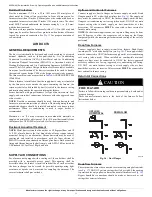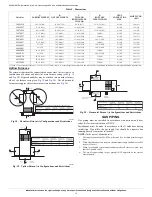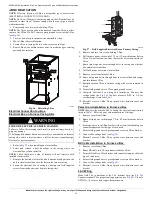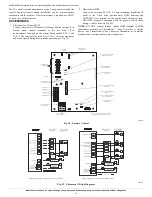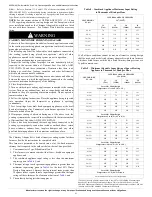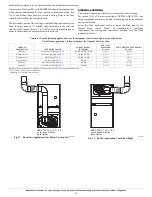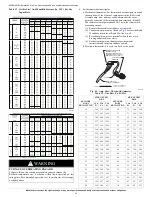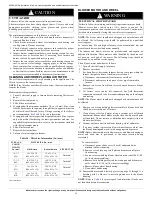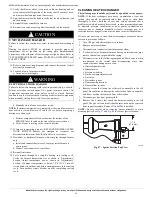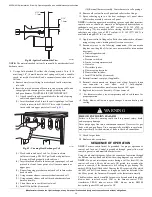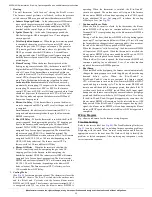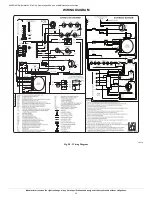
800SA/801SA: Installation, Start–Up, Operating and Service and Maintenance Instructions
Manufacturer reserves the right to change, at any time, specifications and designs without notice and without obligations.
22
Inspections before the sale and at the time of installation will determine
the acceptability of the chimney or the need for repair and/or (re)lining.
Refer to the
to perform a chimney inspection. If the inspection of
a previously used tile-lined chimney:
a. Shows signs of vent gas condensation, the chimney should be
relined in accordance with local codes and the authority having
jurisdiction. The chimney should be relined with a listed metal
liner, Type-B vent, or a listed chimney adapter kit shall be used to
reduce condensation. If a condensate drain is required by local
code, refer to the current edition of NFGC NFPA54/ANSI
Z223.1, Section 12.10 for additional information on condensate
drains.
b. Indicates the chimney exceeds the maximum permissible size in
the tables, the chimney should be rebuilt or relined to conform to
the requirements of the equipment being installed and the
authority having jurisdiction.
A chimney without a clay tile liner, which is otherwise in good
condition, shall be rebuilt to conform to current edition of ANSI/NFPA
211 or be lined with a UL listed metal liner or UL listed Type-B vent.
Relining with a listed metal liner or Type-B vent is considered to be a
vent-in-a-chase.
If a metal liner or Type-B vent is used to line a chimney, no other
appliance shall be vented into the annular space between the chimney
and the metal liner.
EXTERIOR MASONRY CHIMNEY FAN + NAT
INSTALLATIONS WITH TYPE-B DOUBLE-WALL
VENT CONNECTORS
©
NFPA & AGA
APPLIANCE APPLICATION REQUIREMENTS
Appliance operation has a significant impact on the performance of the
venting system. If the appliances are sized, installed, adjusted, and
operated properly, the venting system and/or the appliances should not
suffer from condensation and corrosion. The venting system and all
appliances shall be installed in accordance with applicable listings,
standards, and codes.
The furnace should be sized to provide 100 percent of the design heating
load requirement plus any margin that occurs because of furnace model
size capacity increments. Heating load estimates can be made using
approved methods available from Air Conditioning Contractors of
America (Manual J); American Society of Heating, Refrigerating, and
Air-Conditioning Engineers; or other approved engineering methods.
Excessive oversizing of the furnace could cause the furnace and/or vent
to fail prematurely. When a metal vent or metal liner is used, the vent
must be in good condition and be installed in accordance with the vent
manufacturer’s instructions.
To prevent condensation in the furnace and vent system, the following
precautions must be observed:
1. The return-air temperature must be at least 60°F (16°C)db except
for brief periods of time during warm-up from setback at no lower
than 55°F (13°C) db or during initial start-up from a standby
condition.
2. Adjust the gas input rate per the installation instructions. Low gas
input rate causes low vent gas temperatures, causing condensation
and corrosion in the furnace and/or venting system. Derating is
permitted only for altitudes above 2000 ft. (610 M).
3. Adjust the air temperature rise to the midpoint of the rise range or
slightly above. Low air temperature rise can cause low vent gas
temperature and potential for condensation problems.
4. Set the thermostat heat anticipator or cycle rate to reduce short
cycling.
Air for combustion must not be contaminated by halogen compounds
which include chlorides, fluorides, bromides, and iodides. These
compounds are found in many common home products such as
detergent, paint, glue, aerosol spray, bleach, cleaning solvent, salt, and
air freshener, and can cause corrosion of furnaces and vents. Avoid using
such products in the combustion-air supply. Furnace use during
construction of the building could cause the furnace to be exposed to
halogen compounds, causing premature failure of the furnace or venting
system due to corrosion.
Vent dampers on any appliance connected to the common vent can cause
condensation and corrosion in the venting system. Do not use vent
dampers on appliances common vented with this furnace.
ADDITIONAL VENTING REQUIREMENTS
A 4” (101 mm) round vent elbow is supplied with the furnace. A 5-inch
(127 mm) or 6- inch (152 mm) vent connector may be required for some
model furnaces. A field-supplied 4-inch-to-5-inch (101 - 127 mm) or
4-inch-to-6-inch (101 - 152 mm) sheet metal increaser fitting is required
when 5-inch (127 mm) or 6-inch (152 mm) vent connector is used. See
-
Venting Orientation for approved vent configurations.
NOTE:
Vent connector length for connector sizing starts at furnace vent
elbow. The 4-inch vent elbow is shipped for upflow configuration and
may be rotated for other positions. Remove the 3 screws that secure vent
elbow to furnace, rotate furnace vent elbow to position desired, reinstall
screws. The factory-supplied vent elbow does NOT count as part of the
number of vent connector elbows.
The vent connector can exit the furnace through one of 5 locations on the
casing.
1. Attach the single wall vent connector to the furnace vent elbow, and
fasten the vent connector to the vent elbow with at least two
field-supplied, corrosion-resistant, sheet metal screws located 180°
apart.
NOTE:
An accessory flue extension is available to extend from the
furnace elbow to outside the furnace casing. See Product Data Sheet for
accessory listing. If flue extension is used, fasten the flue extension to
the vent elbow with at least two field-supplied, corrosion-resistant, sheet
metal screws located 180° apart. Fasten the vent connector to the flue
extension with at least two field-supplied, corrosion resistant sheet metal
screws located 180° apart.
2. Vent the furnace with the appropriate connector (see
-
).
3. Determine the correct location of the knockout to be removed.
4. Use a hammer and screwdriver to strike a sharp blow between the
tie points and work the slug back and forth until the slug breaks
free.
CAUTION
!
BURN HAZARD
Failure to follow this caution may cause personal injury.
Hot vent pipe is within reach of small children when installed in
downflow position. See the following instruction.
CAUTION
!
CUT HAZARD
Failure to follow this caution may result in personal injury.
Sheet metal parts may have sharp edges or burrs. Use care and wear
appropriate protective clothing, safety glasses and gloves when
handling parts and servicing furnaces.




